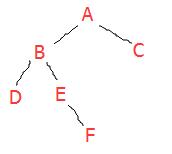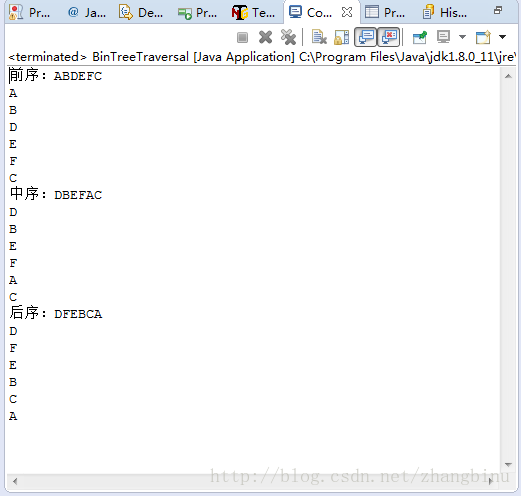java实现二叉树遍历的三种方式
2019-03-28 11:01
447 查看
本文实例为大家分享了java实现二叉树遍历的具体代码,供大家参考,具体内容如下
二叉树如下:

遍历结果如下:

以下是实现代码:
package binTree;
import java.util.Stack;
/**
* @author bin.zhang
* @version 2017年8月29日 上午10:22:01
*/
public class BinTreeTraversal {
public static void main(String[] args) {
System.out.print("前序:");
Traversal.preOrder();
Traversal.preOrderRecursion(Traversal.createBinTree());
System.out.print("中序:");
Traversal.inOrder();
Traversal.inOrderRecursion(Traversal.createBinTree());
System.out.print("后序:");
Traversal.postOrder();
Traversal.postOrderRecursion(Traversal.createBinTree());
}
}
/**
* 节点数据结构
*
* @author bin.zhang
* @version 2017年8月30日 上午11:49:38
*/
class BinTreeNode {
BinTreeNode() {
}
BinTreeNode(char data, int flag, BinTreeNode lchild, BinTreeNode rchild) {
this.data = data;
this.flag = flag;
this.lchild = lchild;
this.rchild = rchild;
}
char data;
int flag;
BinTreeNode lchild, rchild;
}
class Traversal {
/**
* 创建一棵二叉树
*
* @author bin.zhang
* @return 根节点
*/
public static BinTreeNode createBinTree() {
BinTreeNode R3 = new BinTreeNode('F', 0, null, null);
BinTreeNode L2 = new BinTreeNode('D', 0, null, null);
BinTreeNode R2 = new BinTreeNode('E', 0, null, R3);
BinTreeNode L1 = new BinTreeNode('B', 0, L2, R2);
BinTreeNode R1 = new BinTreeNode('C', 0, null, null);
BinTreeNode T = new BinTreeNode('A', 0, L1, R1);
return T;
}
// 前序
public static void preOrder() {
BinTreeNode p = createBinTree();
Stack<BinTreeNode> stack = new Stack<BinTreeNode>();
while (p != null || !stack.empty()) {
if (p != null) {
System.out.print(p.data);
stack.push(p);
p = p.lchild;
}
else {
p = stack.pop();
p = p.rchild;
}
}
System.out.println();
}
// 前序递归
public static void preOrderRecursion(BinTreeNode top) {
if (top != null) {
System.out.println(top.data);
preOrderRecursion(top.lchild);
preOrderRecursion(top.rchild);
}
}
// 中序
public static void inOrder() {
BinTreeNode p = createBinTree();
Stack<BinTreeNode> stack = new Stack<BinTreeNode>();
while (p != null || !stack.empty()) {
if (p != null) {
stack.push(p);
p = p.lchild;
}
else {
p = stack.pop();
System.out.print(p.data);
p = p.rchild;
}
}
System.out.println();
}
// 中序递归
public static void inOrderRecursion(BinTreeNode top) {
if (top != null) {
inOrderRecursion(top.lchild);
System.out.println(top.data);
inOrderRecursion(top.rchild);
}
}
// 后序
public static void postOrder() {
BinTreeNode p = createBinTree();
Stack<BinTreeNode> stack = new Stack<BinTreeNode>(); // 初始化栈
int mark = 1; // 转向标志
while (p != null || !stack.empty()) { // 遍历
if (p != null && mark != 0) {
stack.push(p);
p = p.lchild;
}// 转向左子树
else {
p = stack.pop();
p.flag++; // 退栈
if (p.flag == 1) {
stack.push(p);
p = p.rchild;
mark = 1;
} // 转向右子树
else if (p.flag == 2 && !stack.empty()) { // 输出结点
System.out.print(p.data);
mark = 0;
}
else if (p.flag == 2 && stack.empty()) { // 输出根结点并退出
System.out.print(p.data);
break;
}
} // if-else
} // while
System.out.println();
}
// 后序递归
public static void postOrderRecursion(BinTreeNode top) {
if (top != null) {
postOrderRecursion(top.lchild);
postOrderRecursion(top.rchild);
System.out.println(top.data);
}
}
}
以上就是本文的全部内容,希望对大家的学习有所帮助,也希望大家多多支持脚本之家。
您可能感兴趣的文章:
相关文章推荐
- java线程:三种方式实现生产者消费者问题_2
- Java多线程实现的三种方式
- JAVA多线程实现的三种方式
- WebSocket不同版本的三种握手方式以及一个Netty实现JAVA类
- Java实现多线程的三种方式
- 多线程——Java多线程实现的三种方式
- JAVA多线程实现的三种方式
- 对于实现Java平台的三种方式的详细解析
- JAVA多线程实现的三种方式
- JAVA多线程实现的三种方式
- JAVA多线程实现的三种方式
- JAVA多线程实现的三种方式
- Java多线程实现的三种方式
- JAVA多线程实现的三种方式
- java 实现线程的三种方式 Thread 、Runnable、 Callable Future
- 专业语言:实现Java平台的三种方式
- JAVA多线程实现的三种方式
- java的list几种实现方式的效率(ArrayList、LinkedList、Vector、Stack),以及 java时间戳的三种获取方式比较
- JAVA多线程实现的三种方式
- JAVA多线程实现的三种方式
